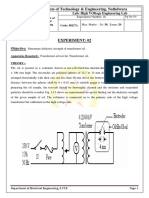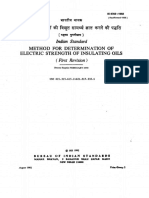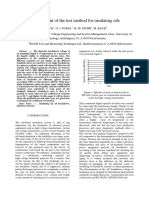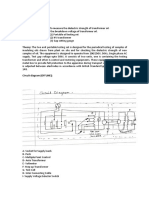0% found this document useful (0 votes)
40 views4 pagesExperiment 4 - Power System Sem 5
The document describes an experiment to measure the breakdown voltage of insulating oil used in transformers. It provides background on insulating oil and factors that affect its dielectric strength. The procedure tests samples in a cell with electrodes using a variable transformer to increase voltage until breakdown. It lists the apparatus used and has spaces for recording test results and calculations.
Uploaded by
ARNAB KAMILYACopyright
© © All Rights Reserved
We take content rights seriously. If you suspect this is your content, claim it here.
Available Formats
Download as PDF, TXT or read online on Scribd
0% found this document useful (0 votes)
40 views4 pagesExperiment 4 - Power System Sem 5
The document describes an experiment to measure the breakdown voltage of insulating oil used in transformers. It provides background on insulating oil and factors that affect its dielectric strength. The procedure tests samples in a cell with electrodes using a variable transformer to increase voltage until breakdown. It lists the apparatus used and has spaces for recording test results and calculations.
Uploaded by
ARNAB KAMILYACopyright
© © All Rights Reserved
We take content rights seriously. If you suspect this is your content, claim it here.
Available Formats
Download as PDF, TXT or read online on Scribd
/ 4























































































